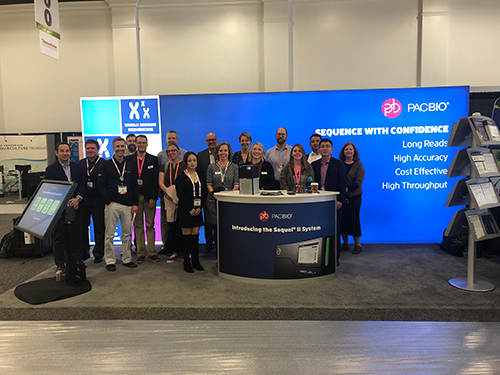ON DEMAND WEBINAR
ON DEMAND WEBINAR
Follow two scientists on their journey of discovery using whole genome sequencing and single-cell RNA sequencing to shed light on previously unresolved medical mysteries. They will share how they have been able to successfully identify the genetic drivers in disease research by accessing the complete genomic landscape, including regions previously deemed impossible to sequence.
Watch the recording to:

Register to watch recording
Monday, January 10, 2022 12:50 PM - 3:00 PM
Town and Country Hotel San Diego
View Program

Christian Henry, CEO, PacBio

Ellie Armstrong, Ph.D., Postdoctoral Fellow, Washington State University

Ted Kalbfleisch, Ph.D., Associate Professor, University of Kentucky

Mitchell Feldmann, Ph.D., Postdoctoral Fellow, University of California, Davis

Michael Eberle, PhD, VP Computational Biology, PacBio

TBP

Christine Liu, PhD Candidate
University of California, San Diego
Cell-type-specific RNA Isoform Diversity in the Down Syndrome Brain
The combination of long-read and short-read sequencing approaches in snRNA-seq has expanded our ability to investigate transcriptomes at a cellular level by allowing us to identify cell types and attribute isoform expression to individual cells. Utilizing both PacBio and Illumina sequencing approaches, we conducted snRNA-seq on 29 human Down syndrome (DS) and non-DS control prefrontal cortex samples. We detected vast RNA isoform diversity within specific cell types that included numerous novel sequences. These results underscore the potential for variable isoform expression to play a role in cellular function.

Tychele Turner, PhD, Assistant Professor
Department of Genetics, Washington University School of Medicine
Long-Read Sequencing as Part of the Pathway to Precision Genomics for Precision Medicine
We recently defined Precision Genomics as “determining all possible relevant genomic variation within an individual to the precise nucleotide.” There are currently several limitations to achieving Precision Genomics and one of these is genomic variation missed due to genomic technology. Long-read sequencing with high accuracy is a ground-breaking advance that enables us to perform analyses to assemble genomes within one day and to detect nearly all forms of variation in one single technology. In this talk, I will discuss my lab’s application of PacBio HiFi long-read sequencing to 9p minus syndrome and autism. In particular, for our study of autism we show how a SMRT Grant from PacBio enabled us to shed light on an unresolved medical mystery for a family.

Jenny Ekholm, PhD, Market Lead, Neurogenetics
PacBio

Jenny Ekholm, PhD, Market Lead, Neurogenetics
PacBio

Presenter name, title, credentials, Presenter name, title, credentials
Monday, October XX X:00 pm PST
Lorem, ipsum dolor sit amet consectetur adipisicing elit. Nulla, aliquid? Totam nobis ad aut. Praesentium eligendi ut, sit illum ex officia, nisi voluptas ea quos dicta non exercitationem earum sed!
Lorem, ipsum dolor sit amet consectetur adipisicing elit. Eveniet quasi corporis, ut consectetur optio aut quas tempore, rerum ipsum vel eaque voluptates magnam a molestiae voluptatibus veniam quos architecto asperiores? Lorem ipsum dolor sit amet consectetur adipisicing elit. A quod deleniti, tempora reprehenderit, vel consequatur odit eveniet distinctio culpa libero ipsam? Ducimus quos amet laboriosam ut perferendis eos similique cum. Lorem ipsum dolor sit amet consectetur, adipisicing elit.

Presenter name, title, credentials, Presenter name, title, credentials

Presenter name, title, credentials, Presenter name, title, credentials
| # | Title | First Author | Date |
| 2046 | Automated repeat characterization of filaggrin from PacBio Sequel HiFi long reads | A. Hawes | February 28, 2022 |
| 2115 | Genomic variant detection within human segmental duplications | D. Soto | |
| 2123 | High-throughput sequencing and mapping technologies applied to 10 human genomes with chromothripsis-like rearrangements | U. Melo | |
| 2153 | Maximizing the quality of RefSeq annotation in the era of big data | S. Pujar | |
| 2189 | Profiling variable-number tandem repeat variation across populations using repeat-pangenome graphs on haplotype-resolved assemblies | T.-Y. Lu | |
| 2304 | Enlightening the dark matter of the genome: Whole genome imaging identifies a germline retrotransposon insertion in SMARCB1 in two siblings with atypical teratoid rhabdoid tumor | M. Sabatella | |
| 2335 | Genome-wide profiling of DNA methylation from a breast cancer and a matched normal cell lines | C. Xioa | |
| 2408 | Protective effect of 1p36.22 Ewing Sarcoma association locus is conferred by an allele specific GGAA-microsatellite duplication leading to TARDBP overexpression | S. Baulande | |
| 2444 | TrueXome technology is used for true gene enrichment and pseudogene suppression | P. Song | |
| 2906 | Identification of VNTR length polymorphism as a driver of local variation in DNA methylation levels | A. Martin | |
| 3024 | Telomere-to-telomere assembly and complete comparative sequence analysis of the human chromosome 8 centromere | G. A. Logsdon * | |
| 3207 | Long-read amplicon sequencing detects a bi-allelic SMN1 & SMN2 gene conversion allele that does not guarantee a spinal muscular atrophy (SMA) phenotype | D. Zeevi | |
| 3208 | Long-read sequencing and optical mapping decipher structural composition of ATXN10 repeat in kindred with spinocerebellar ataxia and Parkinson’s disease | B. Schuele | |
| 3287 | A new approach to Thalassemia and Ataxia carrier screening panels using CRISPR-Cas9 enrichment and long-read sequencing | Y. Tsai | |
| 3305 | Clinical application of long-read sequencing technology to neurodevelopmental disorder diagnosis | S. Hiatt * | |
| 3448 | Identifying novel structural variants at the 17q21.31 MAPT locus in progressive supranuclear palsy using targeted long-read sequencing | H. Walsh | |
| 3487 | Accurate, comprehensive variant calling in difficult-to-map genes using HiFi reads | W. Rowell * | |
| 3494 | Capture long-read isoform sequencing (Iso-Seq) for uncovering human isoform diversity in the brain and characterizing SARS-CoV2viral RNAs | T. Hon | |
| 3512 | Full-length transcript sequencing of human and mouse identifies widespread isoform diversity and alternative splicing in the brain | A. R. Jeffries | |
| 3520 | High molecular weight DNA extraction and long-read next-generation sequencing of human genomic reference standards | M. Mitchell | |
| 3523 | High-throughput HiFi library workflow for Human Whole Genome Sequencing on the Sequel II System | S. Chakraborty | |
| 3628 | Long read sequencing of the SARS-CoV-2 genome and the human immune repertoire | E. Tseng * |
| # | Title | First Author | Date |
| 1062 | A high-resolution panel for uncovering repeat expansions that cause ataxias | Y. Tsai | Febraury 28, 2022 |
Stop by our booth to chat with PacBio staff, get all your questions answered, and see plant and animal genomics in action!
Book a meeting to talk to a PacBio scientist over a cup of coffee. We are excited to learn about your sequencing goals and learn more about your research!
Booth hours: